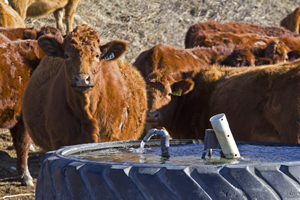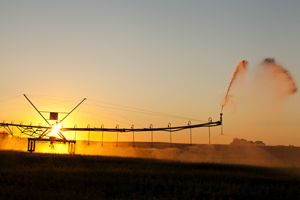The Canadian Beef Industry's Water Footprint is Shrinking
In 2016, the Beef Cattle Research Council’s (BCRC’s) Science Director received 10 letters like this:
“Dear Dr. Bergen…. My name is Emma. I am in 6th grade at Rime Street Elementary. My class found out on vegsource.com that it takes 2,500 liters of water to produce one kilogram of beef. Another site said 25,000 liters…. all these different answers are confusing. My social teacher also showed us a video named Cowspiracy, but it didn’t help. Do you have a dependable answer?”

Eleven-year-olds aren’t the only ones asking these questions. So are consumers, retailers, and others. When the facts aren’t available, exaggerated opinions often fill the gap. A quick google search provides more answers with less consistency. Numbers vary from 100,000 liters/kg (BioScience 47:97-106), 43,000 liters/kg (BioScience 54:909-918); 25,000 liters/kg (Cowspiracy), 16,975 liters/kg (waterfootprint.org) to 15,000 litres/kg (The Economist). A Canadian research team is providing the facts to help us answer these questions, and to help us know how to do better.
A Beef Cluster study led by the University of Manitoba’s Dr. Getahun Legesse Gizaw is measuring how the environmental footprint of Canada’s beef industry is changing. They’ve already reported that each kilogram of Canadian beef generated 15% less greenhouse gas in 2011 than in 1981. A new paper from this team entitled “Water use intensity of Canadian beef production in 1981 as compared to 2011” was just published in Science of the Total Environment.
What they did
Researchers calculated the amount of “blue” and “green” water required to maintain Canada’s beef breeding herd, grow feed, background and finish cattle (including Holstein steers), and process beef in Canada in 1981 and 2011. Blue water (surface or groundwater deliberately used for a specific purpose) mainly includes cattle drinking water used by processing plants, and irrigation. Drinking water was easily calculated; the amount of water cattle drink depends on their age, body weight, weather, and whether they’re lactating. Blue water used to wash carcasses, beef, equipment and laundry in packing plants came from published research, World Bank statistics, and information from packers. Blue water for irrigation came from census information, expert opinion (e.g. types of irrigation systems used for different crops in B.C., Alberta and Saskatchewan), irrigation districts, and provincial government records.
Blue water = surface or groundwater deliberately used for a specific purpose
Green water = precipitation or rain water
Green water (precipitation or rain water) used for dryland feed production was much more challenging to estimate. They first determined which pasture types, forages, feed grains and protein crops were most commonly used in Eastern and Western Canada in 1981 and 2011. For example, using annual crops for extended grazing was unusual in 1981 but quite common by 2011. The amount of water required by each crop at different stages of production was determined from published reports. The same crop may have different water requirements depending on when and where it’s grown. For example, barley seeded in July for swath-grazing experiences different growing conditions and has different water requirements than barley seeded earlier for silage or grain. Yield records for each crop came from 82 Census Agricultural Regions across Canada. Rainfall (green water), temperature, and soil moisture records came from 679 weather stations located within agricultural regions of Canada. Animal and crop data were combined into 49 different feeding scenarios.
What they found
In 2011, producing a kilogram of boneless beef in Canada required 459 liters of blue water and 15,485 liters of green water. Over three-quarters of the blue water was used to produce forage and feed crops. Less than a quarter of the blue water used was consumed by animals, and well below 5% was used to process beef. When green water (rainfall) used by feed and forage crops was included, feed and forage production accounted for over 99% of total water use; drinking water was less than 1%, and water used for beef processing was negligible.

The improvements in crop yields have varied drastically in the last 30 years and this has been reflected in the water footprint of the individual crops that are fed. For example, water use intensity of barley over 30 years stayed relatively stable whereas the water use intensity of corn decreased dramatically. This is because we have seen an increase in corn productivity (the average corn yield in Canada increased from 5,770kg/ha in 1981 to 7,400 kg/ha in 2011) due to both breeding and genetics that has not been seen to the same extent in barley.
Overall, it took 17% less water to produce a kilogram of Canadian beef in 2011 than in 1981. This was mainly due to increased reproductive performance, growth rates, slaughter weights and improved crop yields.
What it means
Because beef’s water footprint is mainly due to crop production, shrinking it further will require improved water use efficiency by feed crops and forages through breeding, management, and improved irrigation practices. These steps will reduce the water footprint of agriculture overall, not just for beef production. Further improvements in feed efficiency will also improve the water footprint as well as the greenhouse gas footprint and overall competitiveness of Canada’s beef industry.
Overall it took 17% less water to produce a kilogram of Canadian beef in 2011 than in 1981.
Including blue water in the calculations makes obvious sense, because we’re choosing to use that water for a specific purpose. Including rainfall (green water) may seem strange, because we can’t choose where it falls. But we are choosing what the land is being used for. Most of the land and water used for feed production is used by forage crops, which also help support ecosystem services like carbon sequestration, biodiversity and healthy watersheds. In many cases, keeping grass and cattle on the land is an environmentally responsible choice.
It’s also important to remember that these numbers talk about total water use and don’t take into account that while we use water to produce beef we don’t use it up. Water is recycled through the water cycle and returned to the environment for future use.
This research is helping the beef industry answer important questions from the public, and is another example of how improving our production efficiency helps shrink our environmental hoofprint.
If you want to learn more about the water footprint of Canadian beef cattle production, feel free to leave a comment below, or contact one of the researchers:
learn more about Beef’s Environmental footprint:
- The Environmental Hoofprint of Canada’s Beef Industry: Producing beef with lower GHG emissions and using fewer resources (BCRC article)
Click here to subscribe to the BCRC Blog and receive email notifications when new content is posted.
The sharing or reprinting of BCRC Blog articles is welcome and encouraged. Please provide acknowledgement to the Beef Cattle Research Council, list the website address, www.BeefResearch.ca, and let us know you chose to share the article by emailing us at [email protected].
We welcome your questions, comments and suggestions. Contact us directly or generate public discussion by posting your thoughts below.